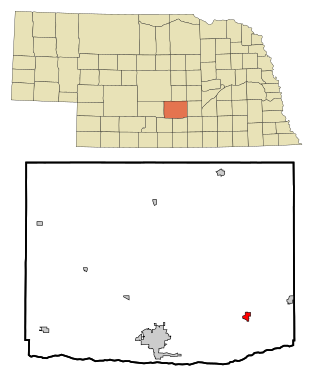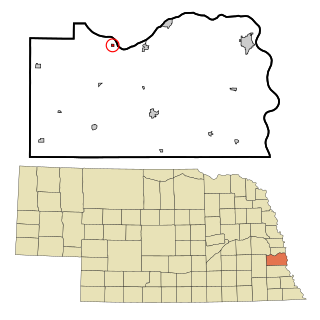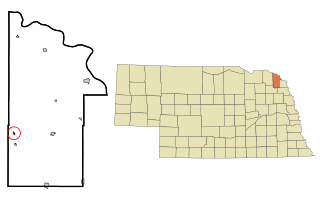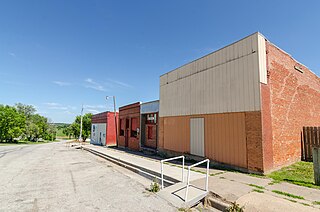
Dixon County is a county in the U.S. state of Nebraska. As of the 2020 United States Census, the population was 5,606. Its county seat is Ponca. The county was created in 1856 and attached to Dakota County. It was organized in 1858.

Roseland is a village in Adams County, Nebraska, United States. The population was 260 at the 2020 census. It is part of the Hastings, Nebraska Micropolitan Statistical Area.

Gibbon is a city in Buffalo County, Nebraska, United States. It is part of the Kearney, Nebraska Micropolitan Statistical Area. The population was 1,833 at the 2010 census.

South Bend is a village in Cass County, Nebraska, United States. The population was 92 at the 2020 census. The main landmark is a pedestrian bridge across the Platte River which leads to Schramm Park State Recreation Area. It was built in 2004 on the pillars of the abandoned Rock Island Railroad bridge. Thirty-five trains a day—most of them coal trains—still pass through the area on the BNSF Railway main.

Edgar is a city in Clay County, Nebraska, United States. The population was 498 at the 2010 census. It is part of the Hastings, Nebraska Micropolitan Statistical Area.

Allen is a village in Dixon County, Nebraska, United States. Located south of US Hwy 20 on NE Hwy 9 between Martinsburg, NE and Wakefield, NE. It is part of the Sioux City, IA–NE–SD Metropolitan Statistical Area. The population was 377 at the 2010 census.

Dixon is a village in Dixon County, Nebraska, United States. It is part of the Sioux City, IA–NE–SD Metropolitan Statistical Area. The population was 87 at the 2010 census.

Martinsburg is a village in Dixon County, Nebraska, United States. It is part of the Sioux City, IA–NE–SD Metropolitan Statistical Area. The population was 94 at the 2010 census.

Maskell is a village in Dixon County, Nebraska, United States. It is part of the Sioux City, IA–NE–SD Metropolitan Statistical Area. The population was 76 at the 2010 census. It is reportedly home to the smallest city hall in the United States.

Newcastle is a village in Dixon County, Nebraska, United States. It is part of the Sioux City, IA–NE–SD Metropolitan Statistical Area. The population was 325 at the 2010 census.

Ponca is a city and county seat of Dixon County, Nebraska, United States. The population was 961 at the 2010 census.

Waterbury is a village in Dixon County, Nebraska, United States. It is part of the Sioux City, IA–NE–SD Metropolitan Statistical Area. The population was 73 at the 2010 census.

Bennington is a city in Douglas County, Nebraska, United States. The population was 2,026 at the 2020 U.S. Census.

Atkinson is a city in Holt County, Nebraska, United States. The population was 1,245 at the 2010 census.

Reynolds is a village in Jefferson County, Nebraska, United States. The population was 59 at the 2020 census.

Creighton is a city in Knox County, Nebraska, United States. The population was 1,154 at the 2010 census.

Humboldt is a city in Richardson County, Nebraska, United States. The population was 800 at the 2020 census.

Salem is a village in Richardson County, Nebraska, United States. The population was 84 at the 2020 census.

Memphis is a village in Saunders County, Nebraska, United States. The population was 109 at the 2020 census.

Emerson is a village in Dakota, Dixon, and Thurston counties in Nebraska, United States. The population was 840 at the 2010 census. Emerson is the only community in Nebraska that exists in three counties.























